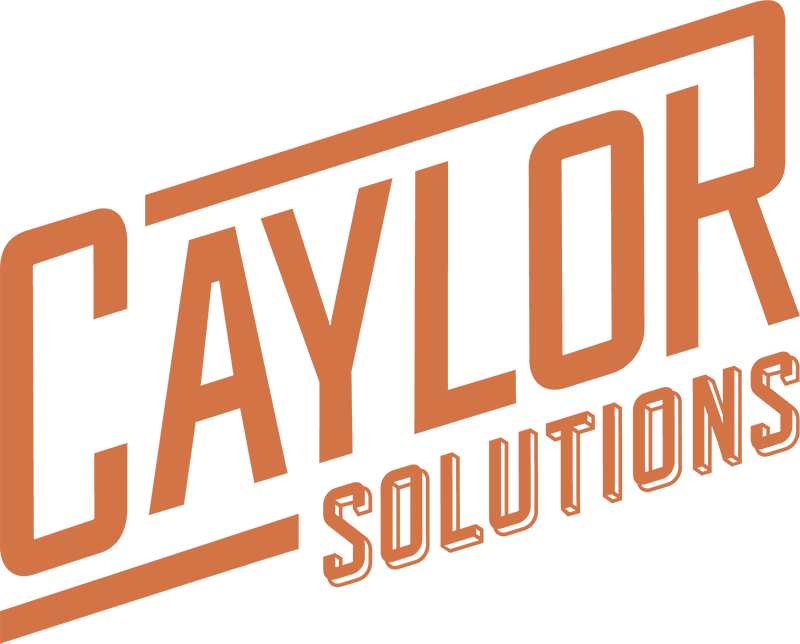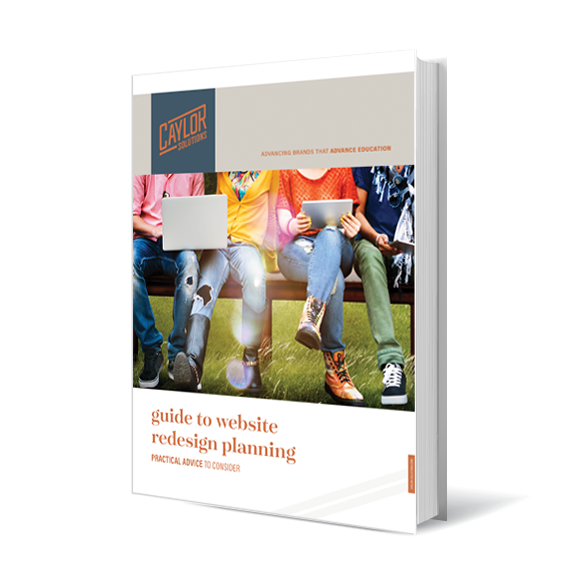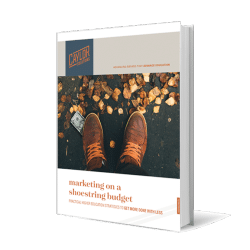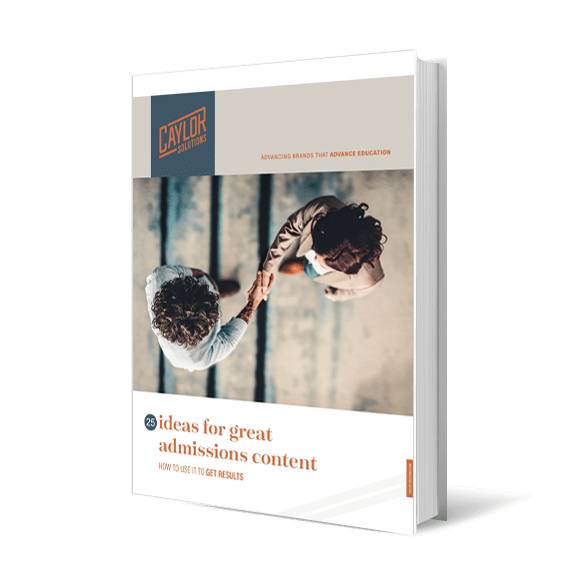When we think about leading organizational change, we almost always think about executive leaders, the president, provost, and vice presidents of our schools.
But marketing is also a critical component of leading organizational change.
By changing the stories shared about the brand, not only can a good marketing team turn around declining enrollment numbers, but they can also shift attitudes and behaviors on the campus itself.
That is a profound and heavy thought as we consider our role and responsibilities as higher ed marketers.

Jenny had a tall order to fill when she arrived at the school in 2021. After nearly a decade of declining enrollment, the university was in desperate need of a branding facelift.
Jenny knew she and her team needed to bring positivity back to the school’s messaging. And she started by taking everyone to “Brand Camp.” Today, Montana has experienced consecutive semesters of growth for the first time in years.
In this episode, we hear how Jenny and her team helped inject confidence back into a bleeding brand by engaging with students and adopting authentic messaging that reflects Gen Z’s priorities.
Branding Woes, Enrollment Decline
We all know the enrollment cliff is a real phenomenon, and almost every school in North America is starting to feel its effects.
However, the University of Montana was already experiencing its own enrollment crisis, due in part to a sexual assault scandal that erupted in 2012.
Jenny shares what was happening at the time she joined the UMT team in the spring of 2021.
From 2011 to 2017, The University of Montana had seen a 40% decrease in the freshman class. They were experiencing a steep enrollment decline [that started] a decade before [I arrived].
On top of that, there was a very public sexual assault scandal that was documented in Jon Krakauer’s book, Missoula. The main hall of our university is on the cover of that book. It was very public. It involved athletics, and so it was very prominent.
On top of that, there were big budgetary issues. The marketing department went from 15 to three members in 2016 because the university offered buyouts.
The very negative publicity caused by the scandal hurt the university’s reputation which led to Jenny’s first marketing initiative, a rebrand that she calls a “brand renaissance.”
And she did it all in a record nine months.
The Rebirth of a Brand
Jenny focused on bringing out what was already there in the UMT brand. She didn’t want people to think that the rebrand was happening because there was “something wrong.”
She wanted it to be more about rebirthing or reinvigorating the good stuff that was already there in the UMT brand, to recapture that feeling of the old “glory days.”
One of the most challenging parts that we found during the research for the campaign was in every focus group we did, we heard the term “glory days.”
Even our current students would say to us, “Gosh! I just feel like I missed the glory days.”
And I thought, what a tragedy to have a school you’ve chosen to come to [be] a school where you think the best days [have already come and gone].
We’ve got to reverse that mental attitude about what’s happening here!
I think most colleges and universities are facing this kind of brand perception today.
We have all heard the stories of notable alumni or an institution’s founders that are so inspiring, but then that excitement fades when the reality hits that this was from a time long gone.
Montana Made. Montana Making.
Jenny’s team partnered with a marketing agency to help them work through the rebranding campaign.
The result of that was a campaign that we call “Montana Made. Montana Making.”
It features what some people think of as a retro color palette, [because] we are still paying [tribute] to the nostalgia and history of this place.
But it’s very fresh in the approach. The language and tone we’re using is not your standard higher ed.
[For example], we’ve got a funny postcard that we’re sending out right now that’s got a tree cutting on it and says, “We love trees so much, we put a ring on them.”
We’re just having fun with it! What we did [in the campaign] was that we infused joy and vibrancy back into the brand.
Even while harkening back to the “glory days,” Jenny and her team were able to show that the good times haven’t stopped.
Strangely, this vibrant connection to the past is what most resonates with their Gen Z target audience.
Listening to the Student Perspective
Historical authenticity and the transparency of current challenges is what attracts Generation Z.
Generation Z also likes to do things together. Combined with the retro aspect that they are drawn to, this collaboration between the marketing team and their Gen Z students was part of the secret sauce that increased enrollment numbers for UM.
Previous branding work [at Montana] hadn’t really included student feedback. We made it a really core center part of what we did [in this rebranding campaign].
When we were working with [the branding consultant], there were three different concepts that they came to, (and they were all beautiful) but this one was the bold, kind of wild concept. The first time I saw it, I was like, “I’m getting fired!”
I had to sit with that uncomfortable feeling and realize it was because there was something there. There was something different that was making me feel differently than what you would typically experience.
So we took the concepts and we did creative testing among different audiences, among our current and prospective student audiences. [The “Montana Made. Montana Making.” brand] was above and beyond the favorite concept.
Often we create marketing that is internal. Essentially, we are marketing to ourselves!
But I was lucky enough to have the support of the president here, and we have seen adoption and excitement around this brand in a way that this campus hadn’t seen before.
I think it’s because it feels like them. They see themselves in it. They know that their feedback was used. It’s fun!
Leading Organizational Change Is Leading Through Discomfort
Jenny is on to something that all marketers need to recognize. Marketing is a part of leadership.
Sometimes, leading organizational change is leading through the discomfort of change itself.
As leaders, we have to understand that it’s not our job to make everybody feel comfortable all the time.
[Personally,] I had that really strong reaction [against the branding feedback we received from our Gen Z focus groups]. Everyone had the same reaction. The first time you see it you’re like, “I don’t know.”
Then, the second time you see it you’re like, “I think I love this!”
Communication and messaging are subjective. Each audience will have a different reaction to the very same campaign.
What may be off-putting to us as marketers may be extremely attractive to our intended audiences.
At Montana, they’re seeing good results in their enrollment as they’ve trusted the feedback of their target market.
Taking these risks in their marketing requires leadership, and that leadership is changing how their people experience and connect their education brand.
I encourage you to listen to our full interview with Jenny Petty to get even more insights into:
- Marketing management and collaborating with outside partners (9:17)
- Incorporating student feedback into higher ed rebranding efforts (15:41)
- Tangible benefits of rebranding and the Ted Lasso effect (20:10)
Want to Improve Your Digital Marketing Results?
Then you’ve got to know how to write for the web. That’s why we want to send you our popular ebook: Writing for the Web: 7 Secrets to Content Marketing Success for Education Marketers!
With this helpful resource, you’ll learn how to:
- Grab your reader’s attention immediately
- Pull your reader’s attention deeper into your content
- Write so that Google (and other search engines) find you easily
- Increase your website’s conversion rates
In short, you’ll be able to write the copy that makes your digital marketing strategy work for you. Download your copy today!
Featured image via umt.edu











